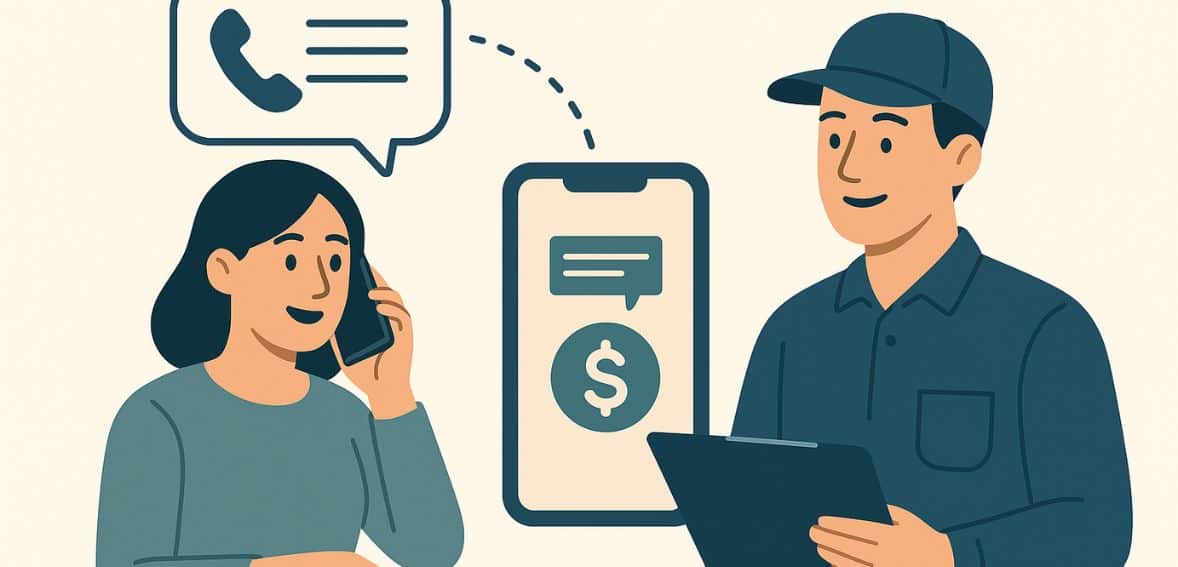
By alphacardprocess October 14, 2025
In today’s fast-paced service industry, convenience is no longer a luxury—it’s an expectation. Traditional payment methods such as cash, checks, or even physical card swipe often create friction, slowing down both the customer experience and business efficiency. Text-to-pay technology offers a transformative solution, allowing customers to complete payments instantly using their mobile devices.
By sending a secure payment link or code directly via SMS, service providers can simplify payment collection, reduce administrative workloads, and strengthen client relationships. Text-to-pay isn’t just a new payment tool—it represents the evolution toward a mobile-first, seamless customer experience. For service-based businesses, it can significantly boost productivity, satisfaction, and revenue collection.
The Rise of Mobile Payments

The widespread adoption of smartphones has permanently changed how customers transact. Consumers now expect digital-first experiences in nearly every interaction—from ordering food to paying bills. Text-to-pay leverages this shift by offering a familiar, frictionless way to complete transactions without apps or logins.
Unlike traditional online portals that require multiple steps, text-to-pay provides a direct SMS link to a secure payment page. This approach reflects modern consumer priorities: speed, accessibility, and simplicity. Businesses that adopt mobile payment technology align with evolving customer behavior, remaining relevant in a marketplace where convenience drives loyalty and repeat business.
How Text-to-Pay Works
Text-to-pay operates through secure messaging systems connected to verified payment processors. After completing a service, the business sends an SMS containing a unique, encrypted payment link. The customer taps the link, accesses a mobile-friendly page, and pays using a preferred method—such as a credit card or digital wallet.
Once the payment is processed, both customer and business receive real-time confirmation. This streamlined workflow minimizes billing errors, accelerates cash flow, and eliminates the need for paper invoices or in-person payments. Integration with CRM or POS systems ensures transactions are automatically recorded, saving valuable administrative time.
Benefits for Customers
For customers, the benefits of text-to-pay are immediate and tangible. The convenience of paying anytime, anywhere through a phone eliminates the need for cash or manual paperwork. Instant payment confirmation provides reassurance, while the ability to save payment methods for future transactions simplifies recurring services.
Text-to-pay removes friction from the payment process, turning what was once a tedious task into a one-step experience. The result is increased satisfaction, stronger trust, and a more positive perception of the service provider—factors that directly influence customer loyalty and repeat business.
Benefits for Service Providers
For service-based businesses, text-to-pay delivers measurable financial and operational advantages. It shortens the payment cycle, reduces missed or late payments, and decreases administrative labor associated with billing and reconciliation. Immediate payments strengthen cash flow, while automated confirmations reduce disputes and accounting discrepancies.
By eliminating the need for technicians to handle payments in the field, service providers can focus on core work quality. Adopting modern, mobile-friendly payment methods also positions businesses as innovative and customer-centric—qualities that help attract and retain clients in an increasingly competitive marketplace.
Enhancing Customer Convenience
Convenience is now the cornerstone of exceptional customer experience. Text-to-pay eliminates unnecessary steps such as mailing checks or accessing complex online portals. Customers can settle payments in seconds, even while on the move.
This simple interaction demonstrates respect for customers’ time and aligns with modern expectations for instant service. Prioritizing convenience doesn’t just improve satisfaction—it deepens relationships. Businesses that make payments easy often enjoy higher retention rates, as customers naturally return to brands that value their time and comfort.
Reducing Errors and Fraud

Automation is one of text-to-pay’s strongest defenses against human error and fraud. Secure gateways use encryption and tokenization to protect sensitive financial information. Each transaction generates digital receipts and timestamped confirmations, creating a verifiable record that reduces disputes.
By minimizing manual entry, businesses also prevent clerical errors common with paper-based invoicing. The layered security architecture of modern text-to-pay platforms builds confidence among customers, who can trust that their payment data remains private and protected. The result is a payment ecosystem that is not only efficient but also inherently secure.
Streamlining Service Calls
For service providers conducting field work—such as HVAC, plumbing, or appliance repair—text-to-pay fits naturally into the operational workflow. Technicians can send payment links immediately after completing a job, allowing for instant transaction closure.
This process eliminates the need to return to the office for billing or follow-up collection calls. It speeds up revenue recognition, reduces administrative bottlenecks, and allows teams to move on to the next service efficiently. Faster payments translate directly to better cash flow and improved customer satisfaction—a win for both sides.
Integration with Existing Systems
Point-of-sale systems, CRM platforms, and service management software can all be integrated with modern text-to-pay solutions. This ensures automatic synchronization of customer data, invoices, and payment status.
Integration minimizes manual data entry, reduces reconciliation errors, and offers a holistic view of customer interactions. Businesses can easily track payment patterns and service histories, enabling more informed decisions. Implementing text-to-pay through existing infrastructure avoids disruption while enhancing overall operational efficiency and financial visibility.
Supporting Multiple Payment Options

Flexibility in payment options is key to encouraging prompt transactions. Text-to-pay platforms typically support a range of methods—credit and debit cards, ACH transfers, or mobile wallets like Apple Pay and Google Pay.
Offering diverse payment options reflects a business’s commitment to customer convenience. It accommodates different preferences and eliminates obstacles that delay payment completion. The more ways customers can pay, the less likely they are to postpone doing so—improving both satisfaction and business liquidity.
Instant Payment Confirmation
Real-time payment confirmation is a major benefit of text-to-pay. Customers are less uncertain because they are notified right away that their transaction was successful. Instant access to completed payments helps service providers track and reconcile their finances.
Because both parties have clear records of the transaction, this transparency increases trust and decreases disputes. Additionally, instant confirmation improves cash flow management by guaranteeing that funds are available on time. For both consumers and businesses, text-to-pay offers a more seamless, comforting experience by giving real-time feedback.
Reducing Late Payments
Late payments are a chronic issue for service providers, often disrupting cash flow and operational stability. Text-to-pay helps address this by removing barriers that delay payment completion. Customers receive the payment link instantly, allowing them to act on it before other priorities intervene.
Automated reminders can also nudge customers to finalize pending transactions. By simplifying the process and encouraging immediacy, text-to-pay effectively shortens the payment cycle. For many service providers, this improvement translates directly into predictable revenue and reduced administrative strain.
Enhancing Customer Communication
Communication is integral to building lasting relationships. Text-to-pay enhances this dynamic by incorporating payment reminders, confirmations, and personalized thank-you messages directly within the same SMS thread.
This direct line of communication eliminates confusion and reduces follow-ups. Customers stay informed at every stage, while businesses can use personalization to make interactions more engaging. Clear, respectful communication fosters trust, reinforcing the perception that the company values not just payment, but the customer experience as a whole.
Mobile-First Experience
Consumers today live mobile-first lives. They shop, bank, and manage schedules from their phones—and expect businesses to meet them there. Text-to-pay fits naturally into this behavioral pattern, offering an experience that feels intuitive rather than imposed.
Businesses adopting mobile-first payment strategies appear forward-thinking and adaptable. They also appeal to younger, tech-savvy audiences who prioritize speed and simplicity. In a world shifting toward full digital transformation, mobile-first isn’t optional—it’s essential for sustained relevance and competitiveness.
Security and Compliance

Payment security cannot be compromised. Text-to-pay systems adhere to PCI DSS standards and employ encryption, tokenization, and multi-factor authentication to protect both customer and business data.
These safeguards reduce the risk of fraud, chargebacks, and reputational harm. Compliance also demonstrates professionalism—customers are more willing to transact with businesses that take data security seriously. Secure text-to-pay solutions reassure clients that convenience doesn’t come at the cost of safety, preserving trust and long-term loyalty.
Ease of Implementation
Contrary to common misconceptions, adopting text-to-pay technology is straightforward. Many providers offer plug-and-play systems that integrate easily with existing operations. Training requirements for staff are minimal, and customers need only a mobile phone to participate.
This ease of implementation minimizes disruption and ensures a quick return on investment. Even small service-based businesses can deploy text-to-pay rapidly, reaping immediate benefits like faster payments, reduced administrative load, and improved client satisfaction.
Tracking and Reporting
Transparency in payment data enhances control. Text-to-pay platforms typically include built-in reporting dashboards that display transaction histories, payment status, and customer behavior trends.
These analytics allow businesses to identify peak transaction times, forecast cash flow, and evaluate staff performance. Tracking also simplifies audits and provides accountability to stakeholders. By transforming payments into actionable data, text-to-pay empowers businesses to make informed, strategic financial decisions.
Improving Customer Loyalty
Convenience is a powerful driver of loyalty. Customers who find a business easy to interact with are far more likely to return. Text-to-pay creates that frictionless experience, reinforcing satisfaction long after the service is complete.
Positive experiences lead to repeat bookings, positive reviews, and referrals. In industries where word-of-mouth matters, simplifying payment can differentiate a brand from competitors. When customers associate a business with ease, reliability, and modern service, loyalty follows naturally.
Competitive Advantage
In competitive service markets, innovation often distinguishes leaders from followers. Businesses that implement text-to-pay signal a forward-looking mindset and a willingness to invest in customer satisfaction.
Modern consumers notice and reward convenience. By adopting cutting-edge payment technologies, companies position themselves as industry innovators. The result is not only increased market share but also improved brand reputation—a decisive edge in attracting and retaining clients.
Reducing Administrative Burden
Manual payment collection, invoicing, and reconciliation are time-consuming. Text-to-pay automates these tasks, freeing staff to focus on customer service rather than paperwork. Automation reduces operational errors and overhead costs while increasing accuracy and efficiency.
Businesses that continue relying on manual or outdated tools risk inefficiencies and client dissatisfaction, making it essential to upgrade outdated payment systems for smoother operations and better customer retention.
Scalability
As businesses grow, payment systems must adapt seamlessly. Text-to-pay is inherently scalable, capable of handling increasing transaction volumes without slowing operations.
Whether processing a few services calls a day or hundreds, the platform maintains reliability and speed. Scalability ensures that as customer demand grows, the business can continue offering the same level of convenience and service excellence. This adaptability makes text-to-pay a future-proof investment.
Personalized Customer Experience
Personalization transforms routine transactions into meaningful interactions. Text-to-pay systems allow businesses to customize messages with customer names, service details, and even tailored thank-you notes.
This personal touch fosters emotional connection, encouraging repeat business and brand advocacy. When customers feel recognized and appreciated, they’re more likely to view the payment process as part of a cohesive, customer-focused experience—rather than a mere transaction.
Supporting Digital Transformation

Text-to-pay aligns perfectly with broader digital transformation efforts. Integrating payment technology into everyday operations streamlines processes, enhances data collection, and promotes efficiency.
By embracing mobile-first, cloud-integrated systems, businesses modernize not only their payment workflows but also their overall service models. This positions them to adopt future technologies more easily and maintain competitiveness in an increasingly digital world.
Future Trends in Service Payments
The future of service payments is defined by speed, security, and integration. Innovations like AI-driven invoicing, digital wallets, and real-time settlements will continue to evolve alongside text-to-pay solutions.
Businesses that adopt such technologies early will benefit from stronger cash flow, improved customer relationships, and lower transaction costs. Text-to-pay is not the endpoint—it’s the foundation of a broader movement toward a fully automated, seamless payment experience.
Conclusion
Text-to-pay is redefining how service-based businesses handle payments—putting speed, security, and customer convenience at the forefront. By integrating mobile payment solutions into their workflows, companies reduce administrative burdens, accelerate revenue, and enhance the overall client experience.
Secure processing, instant confirmations, and mobile accessibility position businesses as modern, efficient, and customer-focused. As consumers increasingly expect mobile-first experiences, text-to-pay offers not just convenience, but a long-term competitive edge.
Ultimately, adopting this technology is more than a financial decision—it’s a statement of commitment to customer satisfaction, innovation, and operational excellence in an evolving digital economy.